Dynamic bridge infrastructure monitoring ![]() Per la versione in Italiano: https://www.stradeeautostrade.it/its-smart-road/monitoraggio-infrastrutturale-dinamico-di-un-ponte/
Per la versione in Italiano: https://www.stradeeautostrade.it/its-smart-road/monitoraggio-infrastrutturale-dinamico-di-un-ponte/
This article illustrates an example of real-time infrastructure monitoring application through the use of triaxial accelerometric sensors (MEMS – Micro Electro Mechanical System), a device which can be configured to detect various parameters such as: vibrations, stresses, etc…
There are several types of sensors that can provide information on structural integrity of a different and complementary nature. They range from force meters in the connection between the joints, to fiber optic sensors that can also detect deformations in structures, to accelerometers that measure vibrations and so on.
The results of the Modal Analysis and the processing of the information collected are the data input for mathematical model capable of detecting changes in the vibration modes (eigenvalues and natural frequencies) in the bridge, which could be indicative of potential damage.
The cyber-physical model consists of simulating the temporal evolution of the structure on the basis of the data collected in a parallel digital environment and making predictions of its behaviour at different future moments, under different evolutions of the load and environmental conditions (e.g. accidents, earthquakes, etc.) with a different level of probability.
The network constantly analyses factors such as vibrations, wind and humidity, and promptly reports anomalies to a computer.
These technologies can also be adapted to existing bridges and viaducts, especially with the use of wireless technologies which do not require interventions on the structures.
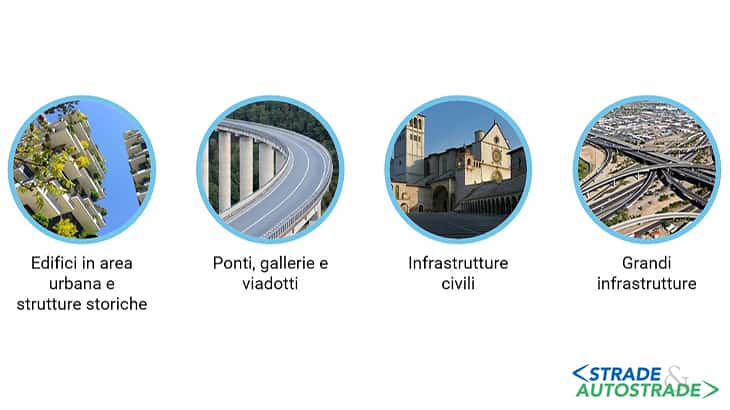
In fact, smart wireless sensor networks are much easier to implement than wired structures, which are more expensive and require special care due to the need to lay cables and drill holes.
Moreover, the installation of the sensors could be difficult to complicated if the interior of the bridge is not accessible. Furthermore, the historical data of the traffic, loading and deterioration processes are not known for the existing bridges, which makes the assessment more complicated, at least as long as there is no statistically significant accumulation.
In the pilot project of Legnano Municipality, a triaxial accelerometric sensor detects the static stresses (vibrations from road traffic) the structure is exposed to. The outcome data was subsequently correlated to extract useful information for the ongoing management of the building.
The system allows to detect anomalous vibration events in order to address two main sets of action:
- prescribing actions, for example following incidental events as the transit of a truck, detected by surveillance cameras and which generates anomalies due to its mass. As a prescription, the transit to that type of masses could be inhibited. In the context of historical structures, howeer, the adoption of conservation policies can be supported through traffic limitation measures. These can reduce collapse or damage risk for the infrastructure related to induced vibrations;
- predictive actions: as part of the preservation of the manufact, the continuous vibrations to which the building is subjected are verified (e.g. traffic). The check is performed by defining analysis matrices along a time continuum in order to identify needs of preventive maintenance.
The measurements carried out can be the basis for analysis, verification and comparison with the calculation models and static data collection. The outcome is used to understand if there are out-of-range parameters, for example, an overpassing of the oscillation range set as the natural behavior for the structure.
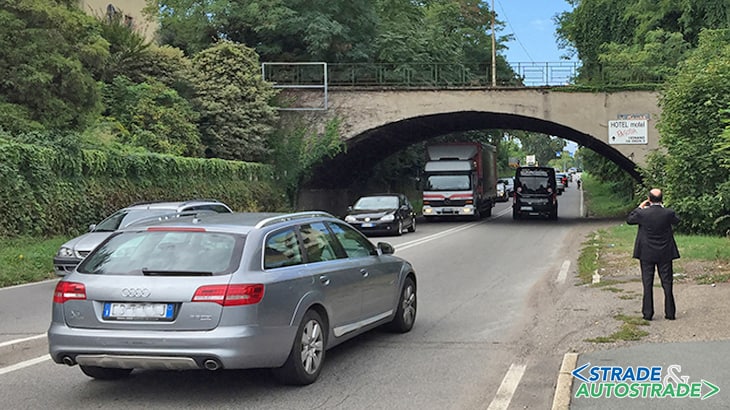
The pilot project in Legnano Municipality
WESTPOLE is an Italian system integrator which supports public and private companies in their Digital Transformation path. With its partners SEINGIM and Area Etica, it has developed an Infrastructure Monitoring project for Legnano Municipality, which recently has launched a program to increase the safety of places and infrastructures through real-time sensor-based analysis solutions.
Among the artifacts taken into consideration, this article focuses on the project implemented on brick and reinforced concrete bridge (located on the road to Castellanza), by a venture of area-specific specialized Companies.
Since December 2018 the installed system monitors the bridge 24/7 and transmits information via internet; once processed, the data related to the integrity of the bridge is available to the Municipality in order to evaluate the most appropriate maintenance works to keep it in perfect condition; the sensor in place detects even minimal oscillations and transmits the data to WESTPOLE cloud which collects and processes the information.
WESTPOLE, through the Service Operations Center located in the Rome office, monitors the functionality of the application, which is able to promptly and proactively alert the competent authorities and professionals in case of anomalous behavior.
The solution is composed of:
- real-time mapping of structures at risk;
- reporting of anomalies and risk prevention;
- real-time sharing of information with all Stakeholders;
- analysis of the behaviour of the structures.
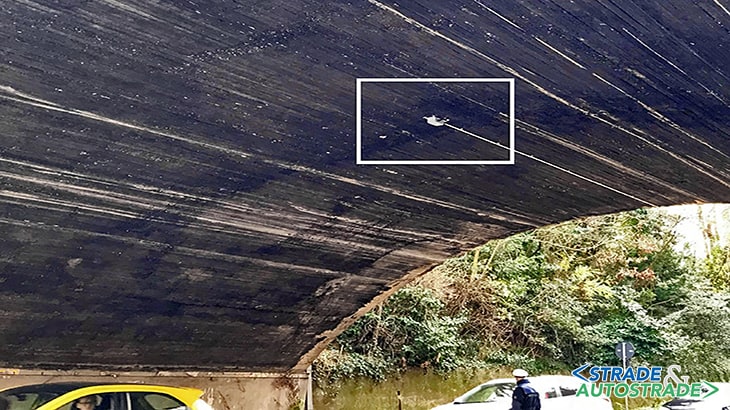
Through the infrastructure monitoring solution created by WESTPOLE, Legnano Municipality therefore equipped itself with a dashboard that provides, in real time, key parameters and related acceptance ranges. Thanks to this dynamic tool any unknown critical issues is highlighted and ignite an effective hierarchy to determine the urgency of interventions.
In addition, thanks to the instrumentation installed on the infrastructure, it is possible to identify critical issues without inspections, but directly thanks to the sensor feedback.
It has to be noted that the service do not only provide detailed data, but thanks to the dashboard and tools quoted above guarantee the simplification of complex data, allowing prompt targeted maintenance and safety actions in the area.
The infrastructure elements of the solution are:
- vibration sensors at high sensitivity, directly installed and integral with the structure to be monitored (Figure 3 above);
- Edge: receiver/transmitter signal from sensor (Figure 4);
- Cloud service;
- software application and dashboard.
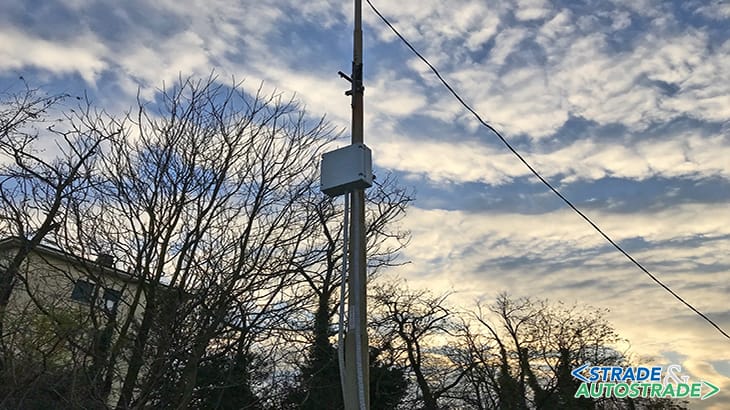
The sensor provides low frequency measurements using 3-axis MEMS acceleration technology:
- low cost compared to the seismograph;
- stable detection including low frequency (0.1 Hz ~ 30 Hz);
- low noise measurement (For piezoelectric sensor type);
- available for outdoor use (Equivalent to IP67);
- online data collection.
The monitored structure is a road bridge – located in Legnano on the road to Castellanza – with a vaulted span in reinforced concrete. The sensor placed in correspondence of the vault, detects the data that are acquired by a system called Edge and, following decoding, are transmitted over the network to the WESTPOLE Cloud, using the existing mobile coverage.
The Cloud infrastructure, properly encrypted, can be reached from a remote terminal with a specific encryption system.
The Edge system (data receiver/transmitter) is installed on site on a streetlight, at a suitable height to protect access and adjacent to the sensors.
All data transmitted by the sensor are stored/historicized in the Cloud and presented by a software application with its own UX.
The data from the sensor is aggregated within the Edge, present in the field, which provides for a more or less profound processing:
- at the first level it normalizes the data and then assimilates it to a functional record for subsequent analysis purposes;
- secondly, if adequate computational capacity is available, it performs analytics functions to report anomalies regarding the recorded solicitations and the need for immediate or planned interventions;
- in the case of sensitive information, it encrypts the data before its transmission and makes the transmission secure;
- the last phase involves sending the data to a centralized aggregation platform for further processing.
The cloud, in the context of infrastructure monitoring, plays an essential role in:
- keeping data safe in the repositories that will be defined by subsets pertaining to the different “edge nodes”; this allows to keep the various contexts isolated in the case of violation of a single edge from a logical or physical point of view;
- performing Machine Learning and Artificial Intelligence analysis to correlate anomalies that occur in the field (for example, with image recognition techniques) in order to reduce the manual interventions necessary to understand the root-cause of the anomaly;
- offering the summary data in schematic dashboards carrying out in-depth analysis in order to allow further investigations over time; for example, it will be useful to indicate critical situations distributed by geolocation, aggregated or summary data (averages, peaks,…), need for maintenance.
Operational activities are divided into two subsets:
- field installation;
- Cloud installation.
Some details of user-side visibility:
- the recorded solicitations in the last 30 calendar days are presented;
- the application is protected by an authentication system based on username and password.
On Figure 5 an example screen.
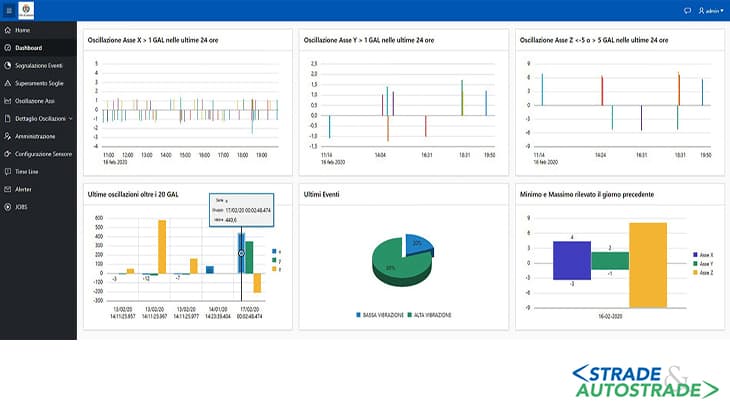
Conclusion
Some of the advantages that the user can derive from the solution and the use of the dashboard are highlighted:
- analysis of the structure by the Municipality that will allow not only to report any unknown critical issues, but also prioritize the urgency of the interventions. The sensors send 8 million oscillations every 24 hours, even minimal, transmitting data to the cloud infrastructure;
- identification of critical issues without site inspections and instrumentation installed on buildings (which may also be carried out separately);
- prevention service which, starting from complex data, provides a tool in which information is simplified and aggregated in such a way that allows targeted maintenance and safety actions in the area;
- solutions customized according to user needs.
Hereby, the main recommended prevention activities:
- mapping of potentially risky infrastructures through an inventory followed by a computerized land register;
- training of experts who use and apply IT in an “Industry 4.0” perspective;
- application of design techniques already tested in relation to the geological fragility of the territory in which it operates;
- updating the legislation summarized in a framework law;
- informed awareness for a greater awareness of the population present in the areas where infrastructures at risk persist.
Who is WESTPOLE
WESTPOLE was born in 2018 as a carve out of the Hitachi industrial Group. Today 100% owned by the financial Group Livia, it is positioned on the market as a reference partner for the digital transformation of companies, thanks to more than 40 years of experience in managing innovative technologies.
WESTPOLE leads companies in the Digital Transformation scale-up, providing the technological tools, expertise and advice necessary to successfully complete the design, implementation, infrastructure monitoring and on-going management of projects.
The strength of the Company is the sum up of Solutions, People and Competences. In the offices of Rome, Milan, Venice and Bologna, over 250 people with more than 1,200 certifications, wake up every day with the aim of supporting customers in their strategic challenges: cloud and edge, infrastructure projects, blockchain applications, security solutions and the most modern Internet of Things and Artificial Intelligence projects, enriched by design and technology management skills.
Who is SEINGIM
Seingim is in the Plant Engineering Company founded in 1999 in Ceggia, in the province of Venice. With ten operating offices in Italy, the Company professionally and competently addresses and resolves all problems related to plant engineering activities, both in the civil and industrial sectors.
The Company operates mainly in the sectors: Buildings, Infrastructures, Energy (production and energy saving), Oil & Gas, Petrochemical, Chemical and Pharmaceuticals, and the scope of activity involves all disciplines of electrical, thermo-hydraulic and HVAC plant engineering, instrumental and automation, fire prevention, environmental (energy audit, saving and energy efficiency).
The team – composed by engineers, technical experts and designers – counts more than 200 employees.
Dynamic bridge infrastructure monitoring ![]() Per la versione in Italiano: https://www.stradeeautostrade.it/its-smart-road/monitoraggio-infrastrutturale-dinamico-di-un-ponte/
Per la versione in Italiano: https://www.stradeeautostrade.it/its-smart-road/monitoraggio-infrastrutturale-dinamico-di-un-ponte/

